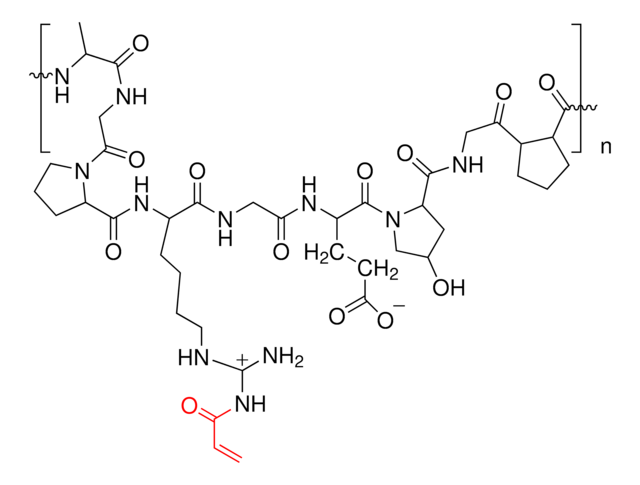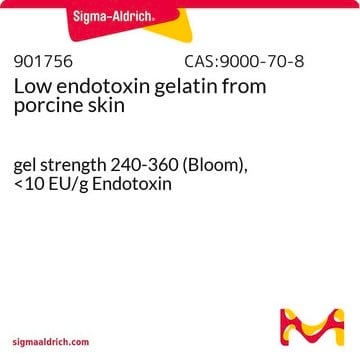900496
Gelatin methacryloyl
gel strength 300 g Bloom, 80% degree of substitution
Synonym(s):
GelMA, Gelatin methacrylamide, Gelatin methacrylate, GelMa, Gelatin Methacrylate
Sign Into View Organizational & Contract Pricing
All Photos(2)
About This Item
Linear Formula:
(C40H59N11O13)n
UNSPSC Code:
12352202
NACRES:
NA.23
Recommended Products
Looking for similar products? Visit Product Comparison Guide
Application
Gelatin methacrylate can be used to form cross-linked hydrogels for tissue engineering and 3D printing. It has been used for endothelial cell morphogenesis, cardiomyocytes, epidermal tissue, injectable tissue constructs, bone differentiation, and cartilage regeneration. Gelatin methacrylate has been explored in drug delivery applications in the form of microspheres and hydrogels.
Storage Class Code
11 - Combustible Solids
WGK
WGK 3
Flash Point(F)
Not applicable
Flash Point(C)
Not applicable
Certificates of Analysis (COA)
Search for Certificates of Analysis (COA) by entering the products Lot/Batch Number. Lot and Batch Numbers can be found on a product’s label following the words ‘Lot’ or ‘Batch’.
Already Own This Product?
Find documentation for the products that you have recently purchased in the Document Library.
Customers Also Viewed
Photocrosslinkable gelatin hydrogel for epidermal tissue engineering.
Zhao X, et al.
Advanced Helathcare Materials (2015)
Covalent attachment of a three-dimensionally printed thermoplast to a gelatin hydrogel for mechanically enhanced cartilage constructs.
Boere KWM, et al.
Acta Biomaterialia, 10(6), 2602-2611 (2014)
Facile one-step micropatterning using photodegradable methacrylated gelatin hydrogels for improved cardiomyocyte organization and alignment.
Tsang K, et al.
Advances in Functional Materials, 25(6), 977-986 (2015)
Ruohong Shi et al.
Small (Weinheim an der Bergstrasse, Germany), 16(37), e2002946-e2002946 (2020-08-11)
Hydrogels with the ability to change shape in response to biochemical stimuli are important for biosensing, smart medicine, drug delivery, and soft robotics. Here, a family of multicomponent DNA polymerization motor gels with different polymer backbones is created, including acrylamide-co-bis-acrylamide
Anh H Nguyen et al.
Acta biomaterialia, 13, 101-110 (2014-12-03)
Gelatin has been commonly used as a delivery vehicle for various biomolecules for tissue engineering and regenerative medicine applications due to its simple fabrication methods, inherent electrostatic binding properties, and proteolytic degradability. Compared to traditional chemical cross-linking methods, such as
Our team of scientists has experience in all areas of research including Life Science, Material Science, Chemical Synthesis, Chromatography, Analytical and many others.
Contact Technical Service











